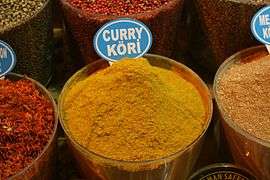Bioenhancer





Bioenhancers or bioavailability enhancers is a new chapter in medical science first scientifically established in 1979 after the discovery of world's first bioenhancer Piperine. It is a pocket friendly drug technology which reduces the destruction, wastage and elimination of several orally administered drugs inside the body.
Definition Bioenhancers are defined as substances that increase the bioavailability and bioefficacy of active substances with which they are combined without having any activity of their own at the dose used. Besides several classes of modern drugs like antibiotics, anti cancer drugs, cardiovascular drugs, anti inflammatory, central nervous drugs, etc., they also increase the bioavailability of vitamins and nutrients.
Increased Bioavailabiity means increased levels of drug in the blood stream available for drug action. Increased Bioefficecy means the increased effectiveness of the drug due to increased bioavailability and also due to other mechanisms.
Significance of Bioenhancers Due to an increased bioavailability, the dose and cost of active drug can be reduced, making the formulation cheaper and safer, better tolerated, having better efficacy, better compliance and having lesser risk of developing drug resistance as in case of antibiotics. As it benefits the dose economy,it is particularly of great value to poor ill diseased segment of society.For example, by reducing the required dose of expensive toxic Rifampicin by 60 percent,it correspondingly reduces the cost and side effects of Rifampicin while treating the dreaded disease Tuberculosis.[1]
History Bioenhancers or bioavailability enhancers as a term and chapter did not exist in any modern scientific literature prior to 1979. The term bioavailability enhancers was first coined in 1979 at Indian Institute of Integrative medicine, Jammu, formerly RRL,Jammu, by Indian scientists (Dr. C. K. Atal, the Director of institute RRL Jammu proposed the hypothesis of increased bioavailability of drugs from a clue during research on traditional medicinal drugs). Subsequently, the concept of bioavailability enhancers was scientifically researched and scientifically established by him and his research team at RRL Jammu. The institute then discovered and scientifically validated Piperine as the world's first bioenhancer using Sparteine and Vasicine which became the world's first experimentally bioenhanced drugs. Dr.Atal also initiated the bioenhanced anti tubercular drug research project using Rifampicin[2] which later resulted in development of world's first bioenhanced anti tubercular drug formulation. This DCGI approved formulation was officially released by Indian government at Anusandhan Bhawan Delhi on world tuberculosis day 2011, and also presented to Mr. Bill Gates, chairman of Microsoft same day at a function at Le Meridian in Delhi.
After the discovery of bioenhancer Piperine in 1979, a new chapter was added in medical science. Since then it has generated global interest and research in the field and has led to discovery of many other new bioenhancers. Piperine remains the most potent and extensively researched bioenhancer till date. It is safe, effective, extremely economical and easily manufactured for commercial use.It is also a broad spectrum bioenhancer acting on several classes of modern drugs as noted elsewhere.
Classification bioenhancers can be classified according to their source of origin, either plant based or animal based or else according to their site of action.
Bioenhancers so far almost exclusively discovered in plants, increase the bioavailability of other substances in different ways:
- Increase of absorption in the intestine
- Inhibition of degradation in the intestine and the liver by inhibition of drug metabolising enzymes (inhibiting first pass mechanism of destruction of drugs).
- Inhibition of elimination in the drug in gut and through bile by inhibition of efflux pumps.
- Increase of drug permeability of pathogens.
- Inhibition of defense mechanisms of pathogens or tumor tissue (such as efflux of drugs)
- Increasing binding possibilities on binding sites (such as DNA and proteins) of the pathogen
- Improving overcoming of the blood-brain barrier
'Reduced bioavailability of orally administered drugs by Destruction, elimination and wastage inside the body
• After oral ingestion and absorption, drugs reach the blood stream where the drug needs to attain a certain desired drug level in the blood to cause desired drug action. • After oral ingestion and absorption, drugs while passing from the gut via the liver to blood stream are inadequately absorbed, wasted, eliminated and destroyed and therefore a reduced percentage of ingested dose reaches the blood stream resulting in lower drug levels in blood. • Therefore, more quantity of drug has to be ingested to compensate for the losses in order to achieve desired blood levels which in turn increase the cost and side effects of drugs.
Billions of Dollars are wasted globally in various countries due to poor bioavailability of drugs, which is a huge financial burden on any nation, particularly poor developing countries.This is particularly relevant in serious and dreaded diseases on mankind like tuberculosis for which treatment is expensive, toxic and prolonged and for which an emergency situation has been declared by UN due to emergence of AIDS and development of serious drug resistance.
'BENEFICIAL ROLE OF BIOENHANCERS'
Reduced dose- Bioenhancers prevent this wastage of ingested drugs inside the body and increase quantity of drug reaching the blood, therefore a reduced dosage of oral drug is sufficient to achieve the desired blood levels.
Reduced burden on raw material of country -This reduced dose needed for desired drug action means beneficial effect on raw materials consumption required to develop drugs which is a great savings for any country.
Ecological advantage- This also translates into ecological advantage in case of rare and expensive plant based drugs as less trees or plant have to be consumed to produce drugs, an example being the costly anti cancer drug Taxol derived from very slow growing Yew trees .
Reduced drug cost- This reduced dose in turn also reduces the cost of drugs.
Reduced adverse reactions- This reduced dose in turn also reduces the side effects of drugs.
Improved compliance- Lesser side effects also improve drug tolerability, drug compliance and promote completion of treatment.
Reduced drug resistance- This improved tolerability and compliance in turn reduces risk of developing dangerous drug resistance.
Added hepatoprotective and gastroprotective actions of bioenhacer piperine reduces gastrointestinal side effects and hepatotoxicity of primary active drug which further makes formulation safer, better tolerated and again reduces drug toxicity and drug resistance.
This is a great advantage to poor patients, poor countries and for dreaded diseases of man.
Examples of bioenhancers
The following examples of bioenhancers give an insight into the current pharmacological research and show how with pepper, curry, ginger and other herbal ingredients in food a lack of nutrients or insufficient effects of active agents can be prevented:
Piperine, an ingredient of pepper, promotes intestinal absorption by activation of the γ-glutamyltranspeptidase and inhibits the degradation of many compounds, by inhibiting different enzymes: aryl hydrocarbon hydroxylase (AHH), ethylmorphine N-demethylase, Uridine diphosphate (UDP) glucuronyltransferase (UGT), P-glycoprotein and CYP3A4. Especially the latter two enzymes contribute significantly to the first-pass effect.
Piperine acts as bioenhancer to vitamins (A, B1, B2, B6, C, D, E, K), amino acids (lysine, isoleucine, leucine, threonine, valine, tryptophan, phenylalanine, and methionine), minerals (iodine, calcium, iron, zinc, copper, selenium, magnesium, potassium, manganese), herbal compounds (including ginsenosides, Pycnogenol), and drugs (such as ibuprofen, diclofenac, rifampicin, ampicillin, tetracycline, vasicine, pyrazinamide, fexofenadine, resveratrol, epigallocatechin, curcumin).
Allicin from garlic enhances the effect of the fungicide amphotericin B on yeast cells by affecting the transport of the fungicide into the yeast vacuole.
Curcumin which inter alia is found in curry inhibits like piperine the enzyme CYP3A4 and affects the transport function of P-glycoprotein. In combination with curcumin an increased bioavailability of the active compounds celiprolol and midazolam was detected.
Ginger promotes due to the gingerols the intestinal absorption of many compounds (including drugs) and elements. In most cases, ginger acts synergistically with piperine.
Glycyrrhizin, a saponin of the liquorice plant, promotes the action of numerous antibiotics and the antifungal agent clotrimazole.
Quercetin, a flavonoid from fruits and leaves, acts like curcumin and piperine. It increases the bioavailability of the active agent paclitaxel used to treat cancer.
Application of research results
The bioenhancer technology is primarily targeted for toxic drugs, expensive drugs, scarce drugs,poorly bioavailable drugs or drugs which need to be given for prolonged periods. However it can also be used in any drugs influenced by bioenhancers. The discovery and characterization of bioenhancers has led to several patent applications.[6][7] Piperine is marketed as bioenhancer in mono preparations and as a component of dietary supplements that contain different vitamins, curcumin, resveratrol or Coenzyme Q10.
Since bioenhancers can reduce the dosage and cost of expensive medication while making treatment safer, its application has for the first time been done in humans in treating tuberculosis for which the existing drugs are toxic and expensive and need to be administered over prolonged periods. In India where low treatment costs for medical care are essential, the drug Risorine is approved against tuberculosis. Besides the antibiotics rifampicin and isoniazid it contains piperine.[8]
Footnotes
- ↑ "Bioenhancers".
- ↑ Zutshi, RK; Singh, R; Zutshi, U; Johri, RK; Atal, CK (1985). "Influence of piperine on rifampicin blood levels in patients of pulmonary tuberculosis". J Assoc Physicians India. 33: 223–4. PMID 4044481.
- ↑ World's first bioenhancer Piperine. (PDF) http://www.iiim.res.in/award-ckatal.pdf. Missing or empty
|title=(help) - ↑ "RRL jammu drug research".
- ↑ Kesarwani, K; Gupta, R; Mukerjee, A (2013). "Bioenhancers of herbal origin". Asian Pac J Trop Biomed. 3: 253–66. PMC 3634921
 . PMID 23620848. doi:10.1016/S2221-1691(13)60060-X.
. PMID 23620848. doi:10.1016/S2221-1691(13)60060-X. - ↑ US 0
- ↑ US 0
- ↑ Atal, N; Bedi, KL (2010). "Bioenhancers: revolutionary concept to market". J Ayurveda & Integrative Med. 1: 96–99. PMC 3151395
 . PMID 21836795. doi:10.4103/0975-9476.65073.
. PMID 21836795. doi:10.4103/0975-9476.65073.
References
- Dudhatra, Ghanshyam B.; Mody, Shailesh K.; Awale, Madhavi M.; Patel, Hitesh B.; Dr; Kronn, Yury; Modi, Chirag M.; Kumar, Avinash; Kamani, Divyesh R.; Chauhan, Bhavesh N. (2012). "A Comprehensive Review on Pharmacotherapeutics of Herbal Bioenhancers". The Scientific World Journal. 2012: 1–33. PMC 3458266
 . PMID 23028251. doi:10.1100/2012/637953.
. PMID 23028251. doi:10.1100/2012/637953.